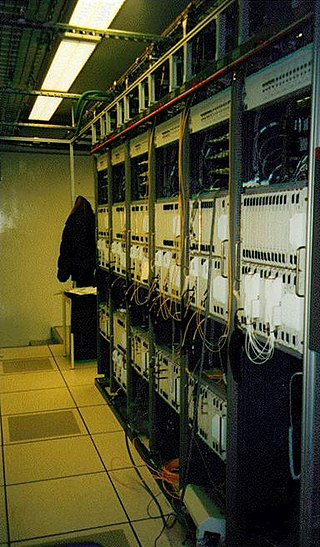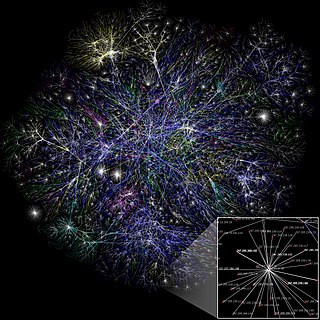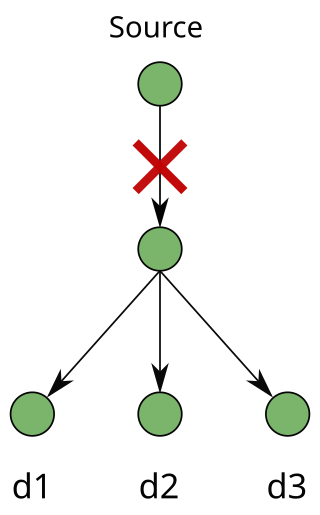
The 5ESS Switching System is a Class 5 telephone electronic switching system developed by Western Electric for the American Telephone and Telegraph Company (AT&T) and the Bell System in the United States. It came into service in 1982 and the last unit was produced in 2003.

Synchronous Optical Networking (SONET) and Synchronous Digital Hierarchy (SDH) are standardized protocols that transfer multiple digital bit streams synchronously over optical fiber using lasers or highly coherent light from light-emitting diodes (LEDs). At low transmission rates data can also be transferred via an electrical interface. The method was developed to replace the plesiochronous digital hierarchy (PDH) system for transporting large amounts of telephone calls and data traffic over the same fiber without the problems of synchronization.

In telecommunications and computer networking, multiplexing is a method by which multiple analog or digital signals are combined into one signal over a shared medium. The aim is to share a scarce resource – a physical transmission medium. For example, in telecommunications, several telephone calls may be carried using one wire. Multiplexing originated in telegraphy in the 1870s, and is now widely applied in communications. In telephony, George Owen Squier is credited with the development of telephone carrier multiplexing in 1910.

In computer networking, Fast Ethernet physical layers carry traffic at the nominal rate of 100 Mbit/s. The prior Ethernet speed was 10 Mbit/s. Of the Fast Ethernet physical layers, 100BASE-TX is by far the most common.

In fiber-optic communications, wavelength-division multiplexing (WDM) is a technology which multiplexes a number of optical carrier signals onto a single optical fiber by using different wavelengths of laser light. This technique enables bidirectional communications over a single strand of fiber as well as multiplication of capacity.

A digital subscriber line access multiplexer is a network device, often located in telephone exchanges, that connects multiple customer digital subscriber line (DSL) interfaces to a high-speed digital communications channel using multiplexing techniques. Its cable internet (DOCSIS) counterpart is the cable modem termination system.
Hybrid fiber-coaxial (HFC) is a broadband telecommunications network that combines optical fiber and coaxial cable. It has been commonly employed globally by cable television operators since the early 1990s.

Small Form-factor Pluggable (SFP) is a compact, hot-pluggable network interface module format used for both telecommunication and data communications applications. An SFP interface on networking hardware is a modular slot for a media-specific transceiver, such as for a fiber-optic cable or a copper cable. The advantage of using SFPs compared to fixed interfaces is that individual ports can be equipped with different types of transceivers as required, with the majority including optical line terminals, network cards, switches and routers.

A passive optical network (PON) is a fiber-optic telecommunications network that uses only unpowered devices to carry signals, as opposed to electronic equipment. In practice, PONs are typically used for the last mile between Internet service providers (ISP) and their customers. In this use, a PON has a point-to-multipoint topology in which an ISP uses a single device to serve many end-user sites using a system such as 10G-PON or GPON. In this one-to-many topology, a single fiber serving many sites branches into multiple fibers through a passive splitter, and those fibers can each serve multiple sites through further splitters. The light from the ISP is divided through the splitters to reach all the customer sites, and light from the customer sites is combined into the single fiber. Many fiber ISPs prefer this system.

Fiber to the x or fiber in the loop is a generic term for any broadband network architecture using optical fiber to provide all or part of the local loop used for last mile telecommunications. As fiber optic cables are able to carry much more data than copper cables, especially over long distances, copper telephone networks built in the 20th century are being replaced by fiber.
An optical communications repeater is used in a fiber-optic communications system to regenerate an optical signal. Such repeaters are used to extend the reach of optical communications links by overcoming loss due to attenuation of the optical fiber. Some repeaters also correct for distortion of the optical signal by converting it to an electrical signal, processing that electrical signal and then retransmitting an optical signal. Such repeaters are known as optical-electrical-optical (OEO) due to the conversion of the signal. These repeaters are also called regenerators for the same reason.

A computer network is a set of computers sharing resources located on or provided by network nodes. Computers use common communication protocols over digital interconnections to communicate with each other. These interconnections are made up of telecommunication network technologies based on physically wired, optical, and wireless radio-frequency methods that may be arranged in a variety of network topologies.
A digital cross-connect system is a piece of circuit-switched network equipment, used in telecommunications networks, that allows lower-level TDM bit streams, such as DS0 bit streams, to be rearranged and interconnected among higher-level TDM signals, such as DS1 bit streams. DCS units are available that operate on both older T-carrier/E-carrier bit streams, as well as newer SONET/SDH bit streams.

An optical add-drop multiplexer (OADM) is a device used in wavelength-division multiplexing (WDM) systems for multiplexing and routing different channels of light into or out of a single-mode fiber (SMF). This is a type of optical node, which is generally used for the formation and the construction of optical telecommunications networks. "Add" and "drop" here refer to the capability of the device to add one or more new wavelength channels to an existing multi-wavelength WDM signal, and/or to drop (remove) one or more channels, passing those signals to another network path. An OADM may be considered to be a specific type of optical cross-connect.
Subcarrier Multiplexing (SCM) is a method for combining (multiplexing) many different communications signals so that they can be transmitted along a single optical fiber. SCM (also known as SCMA, SubCarrier Multiple Access) is used in passive optical network (PON) access infrastructures as a variant of wavelength division multiplexing (WDM).
Wavelength selective switching components are used in WDM optical communications networks to route (switch) signals between optical fibres on a per-wavelength basis.

An optical mesh network is a type of optical telecommunications network employing wired fiber-optic communication or wireless free-space optical communication in a mesh network architecture.

Wavelength switched optical network (WSON) is a type of telecommunications network.

A multicast session requires a "point-to-multipoint" connection from a source node to multiple destination nodes. The source node is known as the root. The destination nodes are known as leaves. In the modern era, it is important to protect multicast connections in an optical mesh network. Recently, multicast applications have gained popularity as they are important to protecting critical sessions against failures such as fiber cuts, hardware faults, and natural disasters.
Fast automatic restoration (FASTAR) is an automated fast response system developed and deployed by American Telephone & Telegraph (AT&T) in 1992 for the centralized restoration of its digital transport network. FASTAR automatically reroutes circuits over a spare protection capacity when a fiber-optic cable failure is detected, hence increasing service availability and reducing the impact of the outages in the network. Similar in operation is real-time restoration (RTR), developed and deployed by MCI and used in the MCI network to minimize the effects of a fiber cut.












